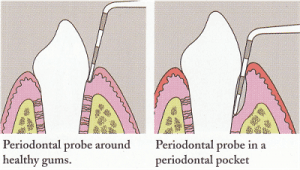Defining terms in a professional environment is essential to effective communication. Failure to convey an accurate message can have legal ramifications or medical consequences. When clarifying one must be conscious of the audience. The words chosen to explain a term must match the reader’s level of knowledge. Definitions must be concise and leave little room for interpretation. My goal for this assignment is to convey a message with exactitude.
Selected term: Periodontitis
Selected situation: I am a dental hygienist working at a periodontal clinic. I meet new patients everyday who have been referred to the clinic for specialized care. The initial encounter is a consultation, when the patient receives an oral examination and a diagnosis. Several terms and procedures are explained to the patient at this appointment and the information is also provided in writing. Because I am working in the health industry, informed consent is required to proceed with treatment. I must accurately describe the patient’s state of health and treatment options using terms they will recognize. The patient needs to fully understand their dental condition to make decisions with confidence. In this scenario, it is my responsibility to explain periodontitis to the patient.
Selected audience: An adult dental patient who does not have technical knowledge of periodontitis.
Parenthetical definition:
Periodontitis (a gum infection that attacks the bone of your jaw).
Sentence definition:
Periodontitis is a chronic inflammatory disease that is characterized by a receding gumline, bad breath, loose teeth, and if left untreated it can lead to tooth loss.(Canadian Academy of Periodontology [CAP], 2020, American Academy of Periodontology [AAP], 2019, Healthline [HL], 2017).
Expanded definitions:
- Operating Principle: Bacterial plaque and tartar accumulation on teeth irritate the gums, causing gingivitis. If the build-up is not removed on a regular basis, the bone around the tooth will wear away (CAP, 2020, AAP, 2019, HL. 2017).
- Comparison and Contrast: Gingivitis is a reversible condition that affects only the gingiva (gums). Symptoms include red, swollen, and bleeding gums. Periodontitis is an irreversible disease that affects the gums and destroys the bone of the jaw. Gingivitis is often the first sign of periodontitis (HL, 2017).
 (Barniv, 2018)
(Barniv, 2018)
- Special Conditions: X-rays and measurement of the periodontal pocket depth are required for diagnosis (CAP, 2020).
- Analysis of Parts: A periodontal pocket is the space between the root of the tooth and the gum. A dental probe is used to measure the depth of the pocket. The probe is marked with lines, like a ruler, and is gently inserted vertically along the side of the tooth, under the gums. A deep periodontal pocket is unhealthy (CAP 2020, AAP 2019).
 (Healthsnap)
(Healthsnap)
- Required Conditions: The most common risk factors for periodontitis are smoking, diabetes, heart disease, and stress. (CAP, 2020, AAP, 2019, HL, 2017).
I created the following document that presents my definitions and images as an example of the reading situation for this assignment. The document is an information pamphlet about periodontitis as well as a welcome letter. It would be given to new patients following a consultation as a reminder of the terms discussed at their appointment and to reassure them of the clinics devotion to their health.
**************************************************************************************************************************************************************
XYZ PERIODONTAL CLINIC (514) 123-4567
WHAT IS PERIODONTITIS?
Welcome to the XYZ Periodontal Clinic family. Today you have been diagnosed with periodontitis (gum disease). Our staff is committed to the rehabilitation of your oral health. It is our goal to guide you through the challenges of periodontitis while preserving your teeth for as long as possible. We provide evidence-based treatment and are dedicated to providing our patients with accurate scientific information.
Now that introduced ourselves and gum disease, lets get a little more technical. Periodontitis is a serious gum infection that attacks the bone of your jaw. It is a chronic condition that can lead to tooth loss if left untreated.
Frequently Asked Questions:
How does periodontitis begin?
Bacterial plaque and tartar accumulation on teeth irritate the gums, causing gingivitis. If the build-up is not removed on a regular basis, the bone around the tooth will wear away.
Is gingivitis the same thing as periodontitis?
Gingivitis is a reversible condition that affects only the gingiva (gums). Symptoms include red, swollen, and bleeding gums. Periodontitis is an irreversible disease that affects the gums and destroys the bone of the jaw. Gingivitis is often the first sign of periodontitis.
 (Barniv, 2018)
(Barniv, 2018)
How is periodontitis diagnosed?
X-rays and measurement of the periodontal pocket depth are required for diagnosis.
What is a periodontal pocket and how is it measured?
A periodontal pocket is the space between the root of the tooth and the gum. A dental probe is used to measure the depth of the pocket. The probe is marked with lines, like a ruler, and is gently inserted vertically along the side of the tooth, under the gums. A deep periodontal pocket is unhealthy.
 (Healthsnap)
(Healthsnap)
What causes periodontitis?
The most common risk factors for periodontitis are smoking, diabetes, heart disease, and stress.
We look forward to seeing you at your next appointment. Should you have any concerns or questions for our staff please to not hesitate to contact us. It would be our pleasure to assist you.
**************************************************************************************************************************************************************
References:
- Canadian Academy of Periodontology. (2020). What is periodontal disease. https://www.cap-acp.ca/en/public/periodontal_disease.html
- American Academy of Periodontology. (2019). Gum Disease information: Types of gum disease, Gum disease risk factors, Gum disease symptoms. https://www.perio.org/consumer/gum-disease.html
- Healthline. (2017, May 22). Periodontitis. https://www.healthline.com/health/periodontitis
- Barniv, Z. (2018). Gum Disease [Image]. Today. https://www.today.com/series/one-small-thing/do-you-need-deep-dental-cleaning-dentists-discuss-t127590
- [Untitled illustration of periodontal probe measurements]. HealthSnap. https://www.healthsnap.ca/blog/floss-gums-health-teeth-dentist-periodontal.html
Leave a Reply